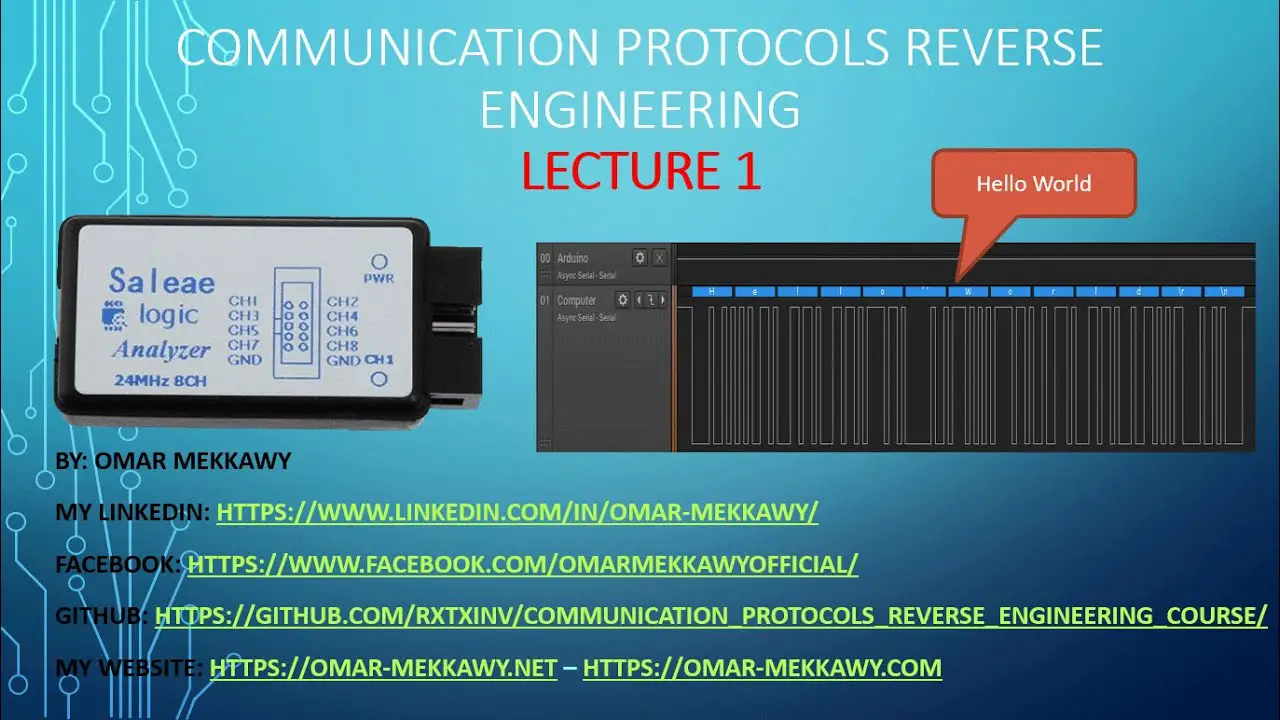Reverse engineering protocols delves into the intricate process of deciphering and understanding the underlying mechanisms of communication protocols. This involves dissecting the structure, functionality, and behavior of these protocols to gain insights into their inner workings. The primary goal of reverse engineering protocols is to extract knowledge and information that can be leveraged for various purposes, such as improving interoperability, enhancing performance, identifying vulnerabilities, and ensuring compatibility.

The process of reverse engineering protocols encompasses several key steps. Firstly, it involves acquiring sufficient documentation and information about the protocol, including its specifications, standards, and any available implementation details. This information serves as the foundation for understanding the protocol’s structure and functionality.

Next, researchers and engineers employ various techniques to analyze the protocol’s behavior. This may involve capturing and analyzing network traffic, examining protocol messages, and conducting experiments to observe the protocol’s responses to different stimuli. These analyses help identify patterns, relationships, and dependencies within the protocol, gradually revealing its inner workings.

A crucial aspect of reverse engineering protocols is developing tools and techniques for dissecting and visualizing the protocol’s data structures and message formats. This enables researchers to gain a deeper understanding of how data is represented, encoded, and exchanged within the protocol. By examining these data structures, they can uncover the protocol’s semantics and the relationships between different fields and components.
Another important step involves identifying the vulnerabilities and potential security risks associated with the protocol. Reverse engineering allows researchers to assess the protocol’s resilience against attacks, such as man-in-the-middle attacks, replay attacks, and denial-of-service attacks. By understanding the protocol’s vulnerabilities, security measures can be implemented to mitigate these risks and ensure the protocol’s integrity and security.
Reverse engineering protocols is not limited to understanding existing protocols. It also plays a crucial role in developing new protocols and enhancing existing ones. By examining and learning from existing protocols, researchers can identify areas for improvement, incorporate innovative features, and design more efficient and secure protocols. This process contributes to the continuous evolution and refinement of communication protocols, driving advancements in various fields, including networking, telecommunications, and distributed systems.
In summary, reverse engineering protocols is a complex and challenging task that involves breaking down the communication mechanisms to gain insights into their structure, functionality, and behavior. Through a combination of analysis techniques, data visualization tools, and experimentation, researchers and engineers can uncover the inner workings of protocols, identify vulnerabilities, enhance performance, and contribute to the development of new and improved communication protocols.# Reverse Engineering Protocols: Breaking Down Communication
Executive Summary
Reverse engineering protocols: Breaking down communication: exploring the inner workings of interaction mechanisms to gain insights into effective communication strategies.
Introduction
Communication is a complex process of sharing information, ideas, and emotions between two or more individuals. The effectiveness of communication relies on various protocols, subtexts, and processes that often occur subtly. Reverse engineering these protocols and mechanisms can provide insights into improving communication strategies to achieve successful interactions.
1. Building Rapport and Mutual Trust
Building rapport and mutual trust lays the foundation for open and effective communication. Fostering a positive environment encourages authentic interactions and productive information exchange.
- Active listening: Demonstrating genuine interest by listening attentively without interrupting.
- Finding common ground: Discovering shared interests, values, or experiences as a starting point for connection.
- Eliminating bias and judgments: Approaching conversations with an open mind, setting aside preconceived notions.
- Respect and empathy: Acknowledging others’ perspectives with empathy and consideration.
- Honesty and transparency: Being genuine and maintaining transparency in interactions.
2. Understanding Body Language and Non-Verbal Cues
Non-verbal communication forms a substantial portion of overall communication. Reading body language, gestures, and facial expressions provides deeper insights into the intended meaning.
- Eye contact: An indicator of engagement, attentiveness, and conversational focus.
- Facial expressions: Conveying emotions, reactions, and attitudes towards the conversation.
- Posture and body orientation: Illustrating interest, receptiveness, or discomfort.
- Hand gestures: Expressing emotions, supporting verbal speech, and indicating enthusiasm.
- Body movement: Displaying unease, nervousness, excitement, or other emotional states.
3. Harnessing the Power of Subtext and Context
Subtext and context play a pivotal role in understanding the deeper meaning behind messages. Uncovering these layers of communication enhances comprehension and ensures intent is accurately conveyed.
- Considering the speaker’s context: Understanding the background, motivations, and perspectives of the speaker.
- Examining the social context: Analyzing cultural norms, societal expectations, and environmental influences.
- Interpreting subtext: Deciphering the underlying meaning between the lines, considering the speaker’s intent and tone.
- Asking clarifying questions: Seeking further information to gain a clearer understanding of the intended message.
- Analyzing non-verbal cues: Observing body language and facial expressions to supplement and reinforce verbal communication.
4. Mastering Active Listening and Constructive Feedback
Active listening and constructive feedback form the backbone of effective communication. These skills enable individuals to comprehend and respond to messages effectively.
- Paraphrasing and summarizing: Restating the speaker’s message in your own words to confirm understanding.
- Asking open-ended questions: Encouraging the speaker to elaborate and provide additional information.
- Demonstrating empathy: Acknowledging and appreciating the speaker’s perspective.
- Providing constructive feedback: Offering feedback in a considerate and actionable manner, focusing on specific behavior and offering suggestions for improvement.
- Being open to receiving feedback: Accepting criticism gracefully and using it as an opportunity for personal and professional growth.
5. Utilizing Effective Communication Strategies for Different Situations
Understanding different communication situations and tailoring strategies accordingly is crucial for successful interactions.
- One-on-one conversations: Establishing a connection, demonstrating respect, and actively listening to foster open communication.
- Group discussions: Encouraging participation, managing dynamics, and facilitating productive collaboration.
- Public speaking: Preparing effectively, adapting to audience needs, and utilizing engagement techniques.
- Written communication: Crafting clear and concise messages, considering the audience and purpose.
- Non-verbal communication: Being mindful of body language, facial expressions, and gestures to convey intended messages.
Conclusion
Reverse engineering communication protocols offers a comprehensive approach to understanding and improving communication strategies. Analyzing elements such as rapport, mutual understanding, context, and non-verbal cues shed lights on the nuances of communciation, laying the foundation for individuals and teams to engage in more effective and purposeful interactions.
Keyword Phrase Tags
- reverse engineering communication protocols
- building rapport and mutual trust
- non-verbal communication
- active listening and constructive feedback
- communicating effectively in different situations

This post is very informative and well-written. I especially appreciate the clear and concise explanations of the different communication protocols.
I found this post to be rather shallow and superficial..
The mention of the ICMP error in paragraph 3 is insightful; I hadn’t considered that.
I disagree with the author’s claim that UDP is a more efficient protocol than TCP. In my experience, TCP has proven to be much more reliable.
It’s funny how the author seems to think that reverse engineering is some kind of magic bullet. In reality, it’s a complex and time-consuming process.
I can’t believe the author actually suggested using a packet sniffer to eavesdrop on network traffic. That’s completely unethical!
Why is the author so focused on the technical details? I’m more interested in the big picture implications of reverse engineering.
This post is a great starting point for anyone who wants to learn more about reverse engineering. I especially appreciate the inclusion of the resources at the end.
I’m disappointed that the author didn’t provide more examples of real-world applications of reverse engineering.
The author’s discussion of the legal and ethical implications of reverse engineering is very helpful. I was unaware of some of the risks involved.
I agree with the author that reverse engineering can be a valuable tool for security researchers. However, I think it’s important to use it responsibly.
I found this post to be very enlightening. I had never considered the role of reverse engineering in the development of new technologies.